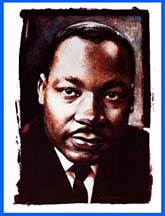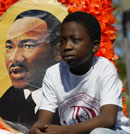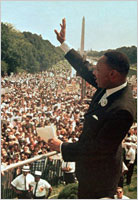|
|
|
 |
|
|
American
Holidays >
Martin Luther King Day |
|
The Reverend Dr. Martin Luther King, Jr. was a black clergyman who is ranked among the greatest of black Americans because of his crusade to win full civil rights for his people. Preaching nonviolence, much in the same way as had Mahatma Gandhi of India, Martin Luther King, Jr. spoke and campaigned tirelessly to rid the United States of traditions and laws that forced on black Americans the status of second-class citizens. Among these laws were those in some states which required black people to take back seats in buses or which obstructed voting by blacks. In the late 1950s and early 1960s, African Americans, led by Dr. Martin Luther King, Jr., used boycotts, marches, and other forms of nonviolent protest to demand equal treatment under the law and an end to racial prejudice. A high point of this civil rights movement came on August 28, 1963, when more than 200,000 people of all races gathered in front of the Lincoln Memorial in Washington, D.C., to hear King say: "I have a dream that one day on the red hills of Georgia the sons of former slaves and the sons of former slaveholders will be able to sit down together at the table of brotherhood....I have a dream that my four little children will one day live in a nation where they will not be judged by the color of their skin, but by the content of their character."
Not long afterwards the U.S. Congress passed laws prohibiting discrimination in voting, education, employment, housing, and public accommodations. The world was shocked when Dr. King was assassinated in 1968. Ever since, special memorial services have marked his birthday on January 15. By vote of Congress, the third Monday of every January, beginning in 1986, is now a federal holiday in Dr. King's honor. See
also: |
|||
| Feature Articles: | |||
Martin
Luther King and the Challenges of a New Age Americans
Celebrate Achievements of Martin Luther King Jr. Martin
Luther King’s Dream Lives on 40 Years After His Death.
By Michael Friedman.
Martin
Luther King's Dream of Racial Equality Martin
Luther King Jr. Memorial Draws Visitors Worldwide |
|||
| Texts
are abridged from U.S. State Department IIP
publications and other U.S. government materials. |
|||
DISCLAIMER
Any reference obtained from this server to a specific commercial product, process, or service does not constitute or imply an endorsement by the United States Government of the product, process, or service, or its producer or provider. The views and opinions expressed in any referenced document do not necessarily state or reflect those of the United States Government. |
 U.S. Diplomatic Mission to Germany /Public Affairs/ Information Resource Centers Updated: September 2010 |


